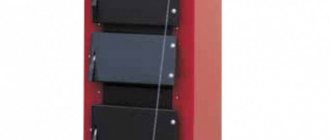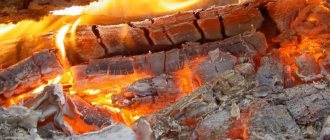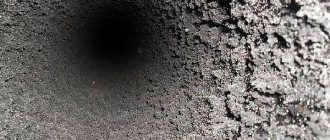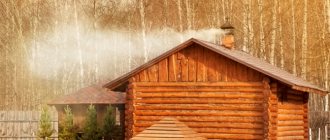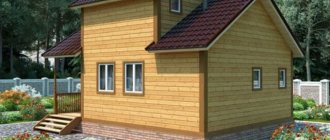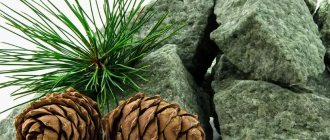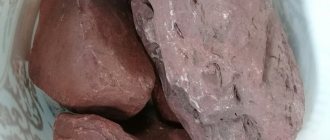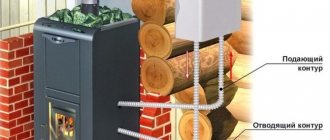It is a priori pleasant to see a live fire in your stove; it creates a cozy and comfortable atmosphere throughout the whole house, but do not forget that its main task is to heat the room. Efficient operation of the stove will allow you to warm up the space of the house at any time of the year and heat the bathhouse.
It is desirable that lighting the stove does not take much time, and the heat from it, on the contrary, lingers for a long time. This can be done by choosing the right fuel, in particular firewood. In this article we will talk about what kind of firewood is best to heat the stove, we will focus on different types of wood, we will study deciduous and coniferous options and specific types of wood.
Nice glowing fire in the stove
The most important characteristics of firewood
Good, high-quality firewood should have the following properties:
- high flammability;
- high heat transfer;
- low ash content;
- low or medium smoke.
All these parameters depend on two factors - the condition of the firewood and the type of wood from which they are prepared. Regardless of what kind of firewood is used in a stove or solid fuel boiler, be it in a house or in a bathhouse, it must be dry.
GarryFORUMHOUSE Member
The stove or fireplace should be heated with air-dried logs with a maximum humidity of 15-25%. Only then will they burn without releasing aggressive substances and effectively provide heat.
The calorific value of firewood varies depending on the type of wood, but even logs of the same type will produce different amounts of heat in dry and wet states. With a humidity of 50%, and for freshly cut wood it can be up to 95%, the specific heat of combustion of a kilogram of firewood is one and a half times lower. Therefore, after harvesting, which necessarily includes chopping logs, the logs are stored in the woodshed for drying. On average, this process takes about two years, but some species dry faster due to the lower moisture content of the wood (birch, ash). If necessary, they can be heated raw, but still not necessary. How much firewood is needed for a season or a year directly depends on the calorific value, and it is still lower for wet ones, therefore, the consumption will be higher. The drying time is also affected by the harvesting season - in any winter firewood the initial humidity is minimal.
How to store it correctly?
To maintain the quality of firewood for a long time, you need to ensure proper storage. No special conditions are required for this; a number of points need to be taken into account:
- The woodpile should not be located in a low place where water can accumulate. Otherwise, the wood may rot.
- Logs should be stacked loosely to ensure good ventilation.
- To provide protection from precipitation, a canopy is made.
- There is no need to stack firewood immediately after harvesting. It's better to do this in a few months.
- It is recommended to store it near the house so that there are no difficulties with access to the woodpile.
Wood species for firewood
If you take dry logs of different types, they differ in the intensity of combustion, and in the amount of heat generated, and in the amount of smoke produced and ash remaining after combustion. The calorific value of wood and its flammability are based on density - the denser the structure, the longer it burns and the greater the amount of heat generated. Which firewood will be better in terms of minimal ash content and low smoke production depends on its mineral composition and the presence of resins.
Coniferous species, with the exception of larch, are characterized by low-density wood and strong resinity, which is why they burn very quickly, emit little heat, and produce a lot of soot. Pine wood produces more heat than spruce, but still less than harder types, and when long-burning firewood is needed, they choose anything but coniferous. Plus, pine logs are not suitable for open fireplaces - when burned, due to the bursting resinous pockets, sparks fly in different directions. But coniferous wood also contains essential oils, which is why it is used as fuel for baths or used for kindling. And for the home, if coniferous firewood is the most accessible, it is worth heating with it, especially when the stove is cold or damp. The main species harvested for firewood are deciduous trees – both “wild” and fruit trees. The latter are especially relevant for smokehouses, as they produce aromatic smoke when burned. To prepare the famous Peking duck, the Chinese not only feed the poultry in a special way, but also use exclusively firewood from fruit trees in the process. To understand which kind of firewood is better in all respects, let’s look at deciduous wood.
Oak - fortress of spirit
Which firewood burns longer? Of course, oak! They are characterized by high strength and density. It is no coincidence that experts jokingly classify this breed as an elite variety, and only then it is valued as a type of fuel. Due to these features, oak logs maintain heat at the required level, produce intense heat, and the negative impact of various external factors does not in any way affect them.
The aroma emanating from the firewood is so pleasant, tart and soft that you can feel the breath of the forest expanses. Like birch, oak can have a beneficial effect on the human body, in particular on the nervous system. It also promotes relaxation and strengthens the immune system.
Wood is long-lived, and finding wood suitable for kindling is not so easy. Not just any logs are suitable for this. Firewood from young plants will not produce much heat, but when old plants burn, a large amount of ash is formed, the air becomes too heavy - not every bathhouse visitor will be able to withstand it.
Heating a house with wood from middle-aged trees works well - they provide just as much heat as needed, or even more. But they are not so easy to find, so oak is rarely used as fuel, and it also grows very slowly.
For reference: once upon a time, good and strong ships were built from oak. Now it is believed that truly tasty and juicy pizza can only be cooked using oak wood. They are also ideal for lighting a fireplace, the only difficulty is that such wood is not easy to split.
Birch firewood
Birch belongs to the category of medium-density wood (550-740 kg/m³), and its ash content varies between 2.43-0.52%. In terms of the amount of heat generated, birch firewood is in the leader group, since the average density is combined with initially lower, and in a dry state, minimal humidity and the presence of tar in the wood composition. However, this carbon compound contributes not only to rapid ignition and intense combustion, but also to increased smoke production with a lack of draft. If you use wet logs and the draft is insufficient, tar will settle on the walls of the chimney. When it is not possible to store and dry a woodpile for a year, but you need to select and heat it in real time, birch will become a real help. The main thing is to ensure good draft so that the wood burns on fire and does not smoke. But for pyrolysis boilers, professionals do not recommend using either wet or dry birch firewood; in this case, other species will be better. Birch bark or splinters are considered the preferred materials for lighting a stove, even if other firewood is of poorer quality.
Oak
If once upon a time alder firewood was considered royal, today the “crown” has passed to oak wood, due to its outstanding properties.
- First density category (750 kg/m³ and more).
- The first category of heat capacity (200-300 kcal).
- Long burning.
When the question arises as to what type of wood is best for heating not only the stove, but also the fireplace, oak wood often wins over others due to the characteristic odor released during combustion. In open fire conditions, this is both pleasant and useful, since aromatization occurs due to the presence of essential oils in the wood. But not everyone will allow themselves to use only oak logs for full-fledged stove heating, since they belong to the upper price segment. You can prepare some of them to put at night or in other cases when you need the longest burning possible. And the bulk of the time is heated with wood with good heat transfer, but from types that are more accessible to a wide range of people. The quality of oak firewood depends on the age of the tree - the older it is, the worse it is; it is recommended to harvest logs from trunks of medium age and size. Due to its high density, even dry oak burns quite slowly and very reluctantly. For kindling, it is more effective to use flammable resinous rocks, dried bark or birch bark.
Deciduous
Larch firewood is better suited for heating in the house. The absence of adhesive substances in them does not cause smoke. Some of these rocks are suitable for kindling.
Alder
Alder is treated as the most beautiful firewood. Alder in the cut section has a varied color shade. It depends on where the tree grows. Conveniences include the fact that you don’t need to dry it.
Oak
Very expensive firebox material to use for firewood. Oak is economical to use. It is often added to other types of firewood. Due to this, more heat is generated in the combustion chamber.
The fiber structure is more dense. This type is not suitable for lighting a stove.
Birch
Birch firewood provides 30% higher heat transfer than other varieties. They contain tar. Thanks to this, the flame flares up quickly and the heat is maintained for a long time.
Birch has its pros and cons. It is not subject to long-term storage. Logs cannot be stored for more than 2 years. There is rot inside them.
Aspen
Aspen firewood, when burned, cleans the chimney. The soot falls down from it and is then removed. They are rarely used because aspen firewood does not produce enough heat.
Poplar
Poplar firewood is used for stoves only because of its low cost. Used when there is no other fuel. They burn quickly and do not produce heat. It is better to take more expensive wood. The payoff will be higher in the long run.
Ash
Ash firewood is rarely used. This is due to the fact that they are not often found, have a very solid structure and a high price. Their good characteristics even exceed oak.
Maple
Maple firewood is rarely used for heating. Maple can be used to make furniture and musical instruments. Therefore, only its waste is used as fuel for the furnace.
Alder
Alder wood is the most beautiful and if you choose from an aesthetic point of view, logs of rich orange, ocher or almost red color will become an excellent decor near the stove. In terms of the amount of heat generated, alder belongs to the second, middle group, although its density is at the level of the third (up to 540 kg/m³). Like birch, the high calorific value of alder is due to the low humidity of the tree even in its raw state, not to mention dry firewood. When burning, alder logs almost do not smoke and do not emit soot at all, as they are characterized by minimal resin content. Alder firewood, wood chips or sawdust are added during smoking to give the smoke a pleasant aroma if wood from fruit varieties is not available. Fireplaces are lit together with birch and alder logs, as they do not crackle, but produce both a beautiful flame and intense heat.
Exotic
As you know, there are quite a lot of tree species, and to list all their types, you could write a thick book, or even more than one.
Therefore, in addition to the varieties listed, it is worth touching on at least a few more:
- Elm. It produces a lot of smoke, is difficult to split and takes a long time to ignite.
- Poplar. Like firewood for a stove - nothing at all. They prick easily, just scatter sparks and burn quickly.
- Beech. It is also difficult to light and split, but can be used raw.
- Fir. Like poplar, it is easy to prick and ignite, but you cannot do without a lot of smoke and sparks.
- Sycamore. Wood is easy to kindle, but difficult to split.
Can they be used for heating in a stove? Everyone can find the answer to this question themselves. But, on the other hand, why not?!
Linden
Like alder, linden firewood has a low density; it is also in the third group and produces less heat - at the level of spruce or poplar wood. Linden, rather from the section on what kind of deciduous firewood is better not to use for heating a house, since the output from them is small and they burn quickly. Consequently, much more of this wood will have to be prepared, and the ash pit will have to be lined and cleaned much more often. Such fuel is unprofitable both financially and unattractive in terms of labor intensity - first the logs will have to be chopped, then the logs will have to be stacked, and then constantly brought in. But when choosing firewood for a bathhouse or for a fireplace, this breed attracts with its aroma, and is even positioned as medicinal. Knowing which firewood is more effective for heating the stove, and which can and should be used for other purposes, you can actually prepare the optimal supply.
Aspen
Aspen firewood is at the bottom of the rating both in terms of density and calorific value, but it burns without smoke, without soot, and without soot. On the contrary, they are used to clean the chimney, since the vapors released by wood during the combustion process can settle on the sooty walls and corrode soot deposits. If you use aspen for periodic burning, it will be much easier to maintain the chimney in working condition. It will not be possible to completely get rid of the need for periodic maintenance, but it is possible to reduce the number of approaches and labor costs. You can also light a stove with aspen splinters; they set quickly. When choosing what kind of firewood will be needed in large volumes, aspen is definitely not in the top. It is enough to prepare a dozen or two logs of it, but if the stove is not only in the house, but also in the bathhouse, and there is also a fireplace, the reserves should be increased.
Beech, ash
In terms of calorific value, beech and ash belong to the first group - they burn for a long time, they give a lot of heat, even if they have lain for only a month or straight from the ax into the oven. Like oak, due to their hardness and density they are reluctant to flare up, but they maintain combustion for as long as possible, due to which less of them are required. But if ash is even more or less available, burning it with beech is an expensive pleasure that should be left for the fireplace or in case of severe frosts.
From fruit trees
The brushwood obtained from regular pruning of garden trees can also be used as firewood, especially if you “bundle” logs from it and light the stove in a cold house. If we consider specifically “fruit” firewood, which is better also depends on density, and in terms of this indicator, middle-aged apple and pear trees win. However, you can very rarely find them on sale and not in all regions, unless you have to uproot trees from your own garden. It is worth using such valuable firewood either for the fireplace, so that the house has a pleasant smell, or for the bathhouse for the same reasons, but it is more advisable to leave it for the smokehouse or barbecue.
Poplar, willow
If fruit firewood is not widely used due to its rarity, heating with poplar or willow wood is simply not practical. They emit minimal heat and burn almost instantly; to warm up the stove, not to mention the house, you will need more than one load. Even taking into account the bargain price or the opportunity to collect poplar trunks for free, after the utility workers, when choosing what kind of firewood to burn, it is not worth considering. Only when there are absolutely no other options, you can “stand still” with such firewood for some short time until you can prepare or buy good ones.
Fruit trees for flavor
Of course, no one will specifically grow fruit trees for the sole purpose of using them for firewood. However, there is still an apple, pear, plum or cherry tree on the site. Over time, you can collect a lot of branches and twigs, which you can put into the firebox. Some people make fires right away, but it would be much more correct to carefully cut them and put them in a woodpile. They are ideal for lighting a sauna, since along with a good and even heat, the combustion of wood produces light steam accompanied by a pleasant, delicate aroma.
It costs nothing to saw and chop firewood; the apple tree is the leader in terms of heat release, and there is practically no smoke. But this choice is more of an aesthetic nature.
